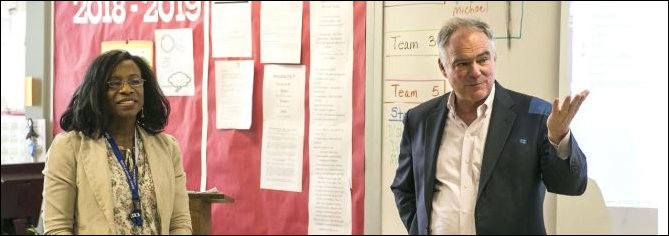
Teacher Selena Erraziqi (left) and Sen. Tim Kaine at Stafford Middle School. Photo credit: Free Lance-Star
Last week, Sen. Tim Kaine, D-Virginia, visited a middle school in Stafford County to discuss the nationwide teacher shortage and ways to increase “respect for the profession.” Kaine has sponsored federal legislation that would, among other things, provide loan forgiveness and other financial incentives to teachers in rural divisions and fund preparation programs at minority-serving institutions.
In a roundtable discussion with teachers, school administrators, school board members and others, Kaine asked for ideas that would strengthen his initiative. For many present, the answer is higher pay,” reported the Free Lance-Star. “I don’t want us to lose sight of the idea that we have to pay for what we value,” said Stafford School Board Vice Chairwoman Sarah Chase. “If we don’t pay enough, then we get what we pay for.”
It comes as no surprise that, if you ask educators how to deal with teacher shortages, they will put higher pay at the top of the list. But we live in the world we live in, in which teacher pay competes with a perceived need for more counselors and support staff, smaller classrooms, newer school buildings, and the like, while exponentially growing Medicaid expenditures are eating the state budget at the expense of other core state responsibilities.
Perhaps part of the solution for dealing with teacher shortages should be… increase the supply of teachers, reduce burnout, or figure out how to do with fewer teachers. Some ideas worth exploring:
- Loosen licensure requirements. Many retirees or people seeking second careers would like to pursue teaching but are restricted from doing so by licensure requirements. While a modicum of instruction on how to handle a classroom may be essential before sending a teacher into a classroom, a lot of the theory taught at schools of education is of marginal value. Loosen licensure requirements at the very least for professions where shortages are most acute.
- Reduce burnout. As one school board member told Kaine, teachers today are expected to be “psychologists, mothers, friends, social workers and protectors of lives” in addition to being teachers. This expectation is tied directly to the erosion of order in classrooms and the introduction of restorative-justice approaches to maintaining discipline. These new disciplinary models need to be evaluated for their impact on teacher morale.
- Use more technology. Computers can’t substitute for teachers entirely but they can supplement teachers in many fields of study (see the Khan Academy), allowing teachers to handle more students in a class. Many school districts have made big investments in technology and laptops at considerable expense. Are they taking full advantage of that investment?
On the topic of teacher licensure… Here is the curriculum for a Master of Teaching degree in mathematics at the Curry School of Education at the University of Virginia:
1ST YEAR
Fall Semester:
EDLF 5011: Adolescent Learning & Development (3 cr.)
EDIS 3882: Field Experience (1 cr.)
EDIS 5020: Instruction & Assessment (3 cr.)
EDIS 5440: Applied Teaching with Technology (2 cr.)–fall or spring semester
EDIS 4884: Field Experience: Mathematics (1 cr.)
EDIS 5450: Teaching Mathematics in Secondary Schools I (3 cr.)
EDIS 5710: Content Area Reading (3 cr.)—fall, spring, or summer semester (>50% online)
Math content studies courses as neededSpring Semester:
EDIS 5000: Exceptional Learner (3 cr.)—fall, spring or summer session
EDIS 5030: Curriculum & Management (3 cr.)
EDIS 3882: Field Experience (1 cr.)
EDIS 4884: Field Experience: Mathematics (1 cr.)
EDIS 5070: Designing Technology Enhanced Solutions (1 cr.)
EDIS 5451: Teaching Mathematics in Secondary School II (3 cr.)
Math content studies courses as neededComplete the online module Child Abuse and Neglect: Recognizing, Reporting, and Responding for Educators.
Complete the online module Dyslexia Awareness Training Module.
Take and pass the reading and writing portions of the Virginia Communication & Literacy Assessment (VCLA).
Take and pass the Praxis II Mathematics: Content Knowledge exam (#5161) offered by the Educational Testing Service (ETS).
Provide documentation of Red Cross (or equivalent) training in First Aid/CPR/AED.
Summer Session (if accelerating the program):
EDIS 7991 Field Project (3 cr.)
EDIS 5175 Issues in K-12 Education (3 cr.)2ND YEAR
EDIS 5874: Seminar: Teaching Internship – Mathematics (3 cr.)
EDIS 5884: Teaching Internship – Mathematics (12 cr.)Spring Semester:
EDIS 7991 Field Project (3 cr.)
EDIS 5175 Issues in K-12 Education (3 cr.)
Tuition and fees for a full-time higher education M.Ed. runs $22,150 for a 12-month program, according to the Curry website. Between the time commitment (earning no pay) and the tuition, that is a not-insignificant barrier. How many of those courses and modules are absolutely essential? Could this be reduced to a single semester — or a single course to give would-be teachers the essential knowledge they need to teach in under-served areas? Is it possible to create a teaching “certificate” that labels a person as qualified to teach, though perhaps less qualified than a teacher who has earned an M.Ed?


